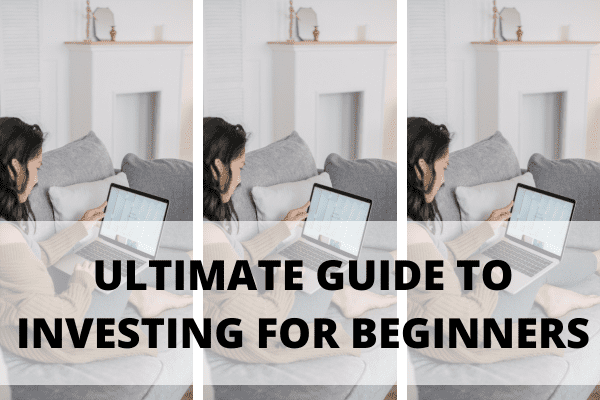This is an ultimate beginner's guide to investing, complete with a step-by-step tutorial and brokerage recommendations.

“How do I invest?” This is the #1 question I get asked on a daily basis.
Therefore, I decided to make an ultimate guide to investing for beginners that will walk you through each step and allow you to make your own financial decisions when it comes to investing.
Investing in the stock market is something we should have been taught in school, but instead, we were taught parallelograms. Very helpful this parallelogram season, right? Ay yi yi…
I wish schools taught us about taxes, how to invest, how to start businesses, how to buy a home, etc. However, they don't teach it so it's up to us to figure these things out on our own, which is something most don't figure out until their later years.
This needs to change.
As you know, I'm on a mission to teach all of the things they should have taught us in school that will help us be successful in life. This includes financial literacy and investing.
In this tutorial, you will learn the steps to invest, the positions to consider investing in, and get a better understanding of the best brokerage to invest with.
This is an ultimate beginner's guide on how to invest.
*Disclosure: I am not a financial advisor. This is not financial advice, just education. Always do your own research before investing. There are ALWAYS risks associated with investing so it's very important to do thorough research before choosing positions to invest in.*
How to Invest in 3 Easy Steps
I know, I know. You always hear that you SHOULD invest, but never HOW to invest.
According to Nerd Wallet, only 48% of women invest in the stock market compared to 66% of men. Whether we're looking at the male or female numbers, those numbers are both low.
That's the problem with the industry. The majority of people don't invest because the industry has made it seem so complicated and a bit scary (which I totally get and understand).
I was there, too, at one point!
Let's fix that today.
It doesn't need to be complicated. Actually, when broken down, it's quite simple.
SO, let's break it down, one step at a time.
Here are the steps to take if you want to invest in the stock market.
Step 1: Open an Account with a Brokerage
This first step will be the hardest decision so we'll spend more time on it.
You have MANY choices when it comes to brokerages to choose from.
I know, it can be a bit overwhelming so I'll break down your options here.
There are 4 different ways you can invest:
- DIY via a Traditional Brokerage
- Robo-Advisor
- Fiduciary
- Financial Advisor
I purposely listed them in my favorite order and will dive into each one in further detail.
Other Articles about Investing:
- Dividend Stocks for Beginners: Guide for the New Stock Investor
- How to Use Robinhood: Beginner’s Guide You Need
- The 5 Best Financial Books that Will Change Your Life
- 9 Extremely Helpful Things You Need to Know About Robinhood Trading
- Robinhood Stock Trading Beginner’s Guide (Get a FREE Stock)
1. DIY via a TRADITIONAL BROKERAGE
Traditional brokerage firms are the ones you've probably heard of many times. These are large corporations that are well known, advertise on TV and may even host your 401k through your employer.
If you are comfortable going the do-it-yourself route, you can choose one of these companies. This will allow you to CHOOSE where to invest your money yourself.
You would choose one brokerage to invest your money with and then decide the positions you want to invest in, all on your own.
All of them will carry all of the NYSE stocks and they will each carry certain index funds, ETFs and mutual funds.
You can't go wrong with the ones I list below.
Here are my 4 favorite brokerage firms to invest with:
a. Vanguard
Vanguard is one of the largest brokerages and one of my favorites. They offer some of the best-performing index funds and have been around for quite some time.
Vanguard also offers a plethora of services and has amazing customer service.
You can't go wrong with either brokerage, in my opinion. Both are great companies. It's up to you to decide what your investments will be.
*Most brokerages have zero trade fees these days, but you'll want to double-check to make sure before you invest.*
b. Fidelity
Fidelity is another large brokerage and one that offers a lot of value. They have excellent customer service and have a plethora of options when it comes to investing, financial management, and retirement.
You may have your 401k through your employer with Fidelity. If so, you already have a brokerage account and just need to call them to set up an individual account to start investing outside of your 401k retirement, if that's what you're looking for.
*Most brokerages have zero trade fees these days, but you'll want to double-check to make sure before you invest.*
c. Charles Schwab
Schwab is another great option for a brokerage firm. If you already have an account with them, you may want to just add an individual investing account to the mix to limit the number of bank accounts you have.
They don't offer as many resources as the two above, but they're still a great brokerage with many mutual and index funds to choose from.
*Most brokerages have zero trade fees these days, but you'll want to double-check to make sure before you invest.*
d. Robinhood
I purposely listed Robinhood fourth. Robinhood is one of my favorite brokerages so I had to make sure it made the list.
HOWEVER, Robinhood needs its own disclaimer as the app is SO EASY to use that it seems to encourage short-term investing instead of long-term investing.
As we know, investing is typically (and should be) a long-term game. (Even Warren Buffett says so!)
Therefore, while Robinhood is great for learning the stock market (which is what I recommend it for), my long-term plays are always in a larger brokerage account.
Robinhood is fantastic for a beginner that just wants to SEE how this all works. If you're that person that wants to learn, Robinhood would be good to start out with.
However, once you understand it, I'd recommend using a long-term investment brokerage.
Robinhood will always be one of my favorites because they have ZERO trade fees!
Articles about Robinhood you'll enjoy:
- How to Use Robinhood: Beginner’s Guide You Need
- 9 Extremely Helpful Things You Need to Know About Robinhood Trading
- Robinhood Stock Trading Beginner’s Guide (Get a FREE Stock)
There are a plethora of brokerage options to choose from. These are just a few of my faves. If you've picked a brokerage, you can move on to Step 2.
However, if you aren't comfortable with investing on your own, there are 3 other ways you can do it! Let's discuss.
2. ROBO-ADVISORS
In recent years, Robo-Advisors have hit the world by storm…and for good reason.
This is a great option for those that don't feel comfortable investing on their own but also don't want to pay the high cost of a financial advisor.
In the past, the only way one could invest was with a financial advisor, which was typically only available to the wealthy.
Then, brokerages started allowing anyone to invest on their own. But still, choosing positions can be daunting for most.
Therefore, the robo-advisor was born.
These robo-advisor sites will ask you a series of questions related to your goals, age, family, retirement plans, etc. They will essentially ask you EVERYTHING that could somehow be related to your finances.
All of this information goes into an algorithm.
This algorithm then tells the system what your risk tolerance level is and aligns it with your goals. The system will then decide on your investments for you and automatically invest your money.
There isn't much you need to think about and it makes it very simple for the average person to invest.
There are pros and cons to this method.
One of the pros is that many robo-advisors will automatically adjust the allocation for you so let's say your stocks grow to be 90% of your portfolio, but your financial plan was supposed to have stocks at 60%. The Robo-Advisor site will automatically reallocate your funds to appropriately align with your goals. (Check with your robo-advisor first to confirm whether or not they do this.)
This helps to protect you from any downturns in the market.
In the DIY way above with a large brokerage firm, you'd need to reallocate on your own every 6 months to a year.
One of the cons is that the Robo-Advisors don't do tax loss harvesting because they are automatic algorithms. If tax loss harvesting is important to you, you may want to go a different route.
Here are some of my favorite Robo Advisors:
a. M1 Finance
M1 Finance is a brokerage account that serves as a Robo Advisor. You’ll plan for retirement and aim to gain long-term wealth via the financial strategies they recommend.
They’ll help you decide your financial plan based on risk factors, goals, etc.
Not only will you invest your money long-term with M1, but you can also do several other things. You can open an IRA, establish a joint account for marriage, purchase fractional shares, and get a better understanding of your financial plan.
Like Robinhood, they also don’t have fees!
b. Acorns
Acorns is an interesting app because it automates investing for you in a whole different way. It allows you to invest your spare change by simply “rounding up” your purchases.
You can also set up recurring investments like you would with any other brokerage. It offers a simplistic platform and provides beginner coaching on investing.
It’s a perfect app for a beginner investor and someone that struggles with budgeting. My readers will receive $10 for signing up with my link.
There are many robo-advisors out there nowadays.
What's important is that you find a reputable company with great customer service and a plethora of options/resources.
However, if you're still unsure and don't want to invest on your own or with a robo-advisor, there are 2 other options for you.
3. FIDUCIARY
The 3rd way to invest is with a fiduciary.
A fiduciary does basically the same thing a financial advisor does but differs in one very important way.
Usually, fiduciaries are fee-based advisors vs commission-based advisors.
A fiduciary will typically charge a flat 1-3% fee for financial advice and may even operate your investing strategy for you. However, they will typically just take a flat 1-3% fee.
This is important to note because your percentage fee will not change and their pricing is transparent, regardless of the positions they put you in.
They will invest your money or give advice on how to invest it (like a financial advisor would), but they don't have a financial interest in the positions they put you in since they don't make a commission on your investments.
This brings me to financial advisors.
4. FINANCIAL ADVISOR
Most financial advisors are very expensive.
The worst part is though, they don't SEEM expensive because you never see the fees. They are hidden and taken out of your investments.
They make a commission off the investments they put your money into.
Can you imagine that in any other industry? Ex: I take your money and since I'm going to make 6% commission on XYZ investment, I put it in that XYZ fund, rather than another ABC fund that would have only cost you 1%.
Yikes!
In my opinion, they are too expensive and certainly don't offer anything more than a fiduciary does.
I can say these things because my parents were once burned by a financial advisor when I was a little girl and they lost everything they had overnight.
It's not their fault though. Up until a few years ago, investing through financial advisors was pretty much the only way people invested.
I, too, have been burned by a financial advisor. I found out I had been paying 7% in fees every year based on the investments they had put me in.
Ouch.
You live and you learn. Now I do my own investments.
Either way, if you choose to invest with a financial advisor, make sure you understand all costs (not just the expense ratio). They want you to focus on the expense ratio, but that's just one of over 10 costs they are charging you on the back end that you will never see or know about (no matter how many times you ask).
Okay, after you've picked a WAY to invest, we'll go to the next (and easier steps).
Step 2: Put Money into the Account
The next steps are fairly simple.
After you've chosen a brokerage account of some sort, you will connect your bank account.
This bank account will most likely be your checking account and not your high-yield savings account.
As a reminder, your high yield savings account is only for your 5 year goal money and emergency fund since it only allows 6 withdrawals per month. This way, that money is liquid if your investments drop.
You can read my ultimate guide to HYSAs here.
After you've connected your bank account, simply decide how much you'd like to contribute.
Most of the brokerages and robo-advisors will allow for automatic payments. Feel free to set those up per month so that the money automatically contributes to the investing account.
This way, you never have to see the money as it will auto-invest itself.
Step 3: Choose Positions (for DIY and some Robo-Advisors)
The third step in the investing process is to choose positions.
This step will mainly be for our do-it-yourself folks and some robo-advising companies (if they allow you), Fiduciaries and financial advisors will do this step for you.
Some common position options to choose from will include:
- Stocks
- Bonds
- REITs
- Dividend Stocks
- Index Funds
- Target Date Funds
- Mutual Funds
- ETFs
- Crypto (only for some brokerages. As a beginner, avoid for now.)
It's important to research all positions before investing your hard-earned money.
You should also be cautious not to invest all of your money into stocks or all into bonds as you want to make sure you have a well-rounded portfolio.
These investing books will help you further understand the different positions and how to decide what your allocation will be.
How do Taxes Work with Investing
It's important to note how taxes work with investing as simple mistakes could lead to leaving money on the table.
Investments in the stock market are taxed as capital gains if the stock was held for longer than a year.
Now, remember, I only encourage long-term investing so this is right in line with what I preach.
Capital gains tax brackets are a much smaller percentage than normal income tax percentages. In 2021, capital gains are taxed at 0%, 15%, or 20% depending on different factors.
If the stocks are sold in less than a year, you will be taxed at your normal income tax bracket (which is typically very high in comparison).
This is why it's very important to note how long a stock has been held before selling it.
How to Invest Summary
By the end of this post, you should be able to identify your preferred method for investing, opened up a brokerage account, and chosen your positions.
As a reminder, the stock market is ALWAYS a risk so do thorough research before investing in anything. I will not give my recommendations as I am not a financial advisor and everyone's investing journey is different.
The good thing about the stock market is that it's been proven to increase over time. While it will fluctuate greatly from year to year, the trajectory over time has increased.
This is why it's so important to exercise patience and stick to your financial strategy when investing in the stock market.
Other Articles about Investing
- Dividend Stocks for Beginners: Guide for the New Stock Investor
- How to Use Robinhood: Beginner’s Guide You Need
- The 5 Best Financial Books that Will Change Your Life
- 9 Extremely Helpful Things You Need to Know About Robinhood Trading
- Robinhood Stock Trading Beginner’s Guide (Get a FREE Stock)
*Disclosure: I am not a financial advisor. This is not financial advice, just education. Always do your own research before investing. There are ALWAYS risks associated with investing so it's very important to do thorough research before choosing positions to invest in.*







How do you feel about Target Date Funds?
Great question!! I love them! I think if people want a hands-off approach, they are great because you don’t have to think about anything!! =)
What is your take on Variable Annuities ?